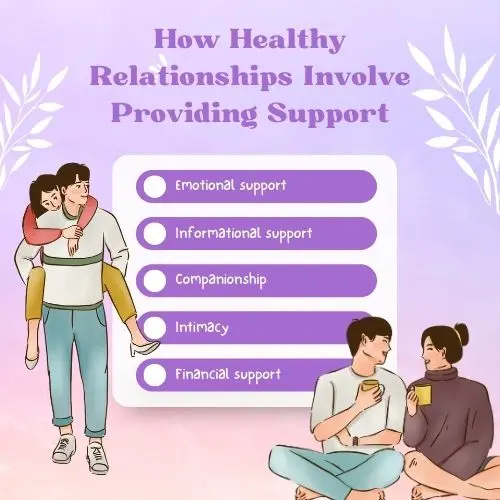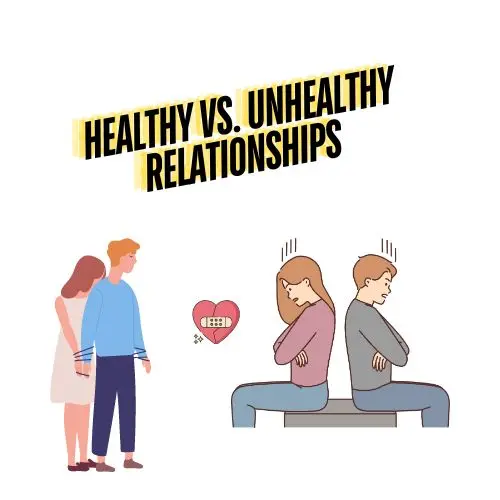What is a Healthy Relationship?
A healthy relationship is built on love, mutual care, trust and respect between both partners. It allows each individual to feel supported while also pursuing personal growth and fulfilment.
Communication and Understanding
Partners engage in open and respectful communication by expressing their needs and feelings clearly. They make sincere efforts to listen, overcome assumptions and truly understand each other’s perspectives.
Compromise
Both partners balance their interests with the interests of their relationship through sensible compromises. They realize they can’t always get their way and are willing to find a middle ground.
Intimacy
Partners nurture physical and emotional intimacy through mutual affection, caring behaviors and sharing vulnerabilities that bring them closer over time.
Trust and Honesty
A healthy degree of trust exists between partners based on honesty. They can share problems candidly without fear of judgment and give each other the benefit of the doubt.
Support and Encouragement
Partners provide emotional support, especially during difficult times. They uplift each other and celebrate individual successes instead of getting insecure or competitive.
Shared Values and Visio
Having a basic alignment of moral principles and vision for their shared future together enhances mutual understanding between partners over the long run.
Independence
The relationship gives adequate personal space and independence to each partner for pursuing individual friendships, interests, hobbies and personal growth along with nurturing the bond between them as a couple.
Effort
Partners consciously make efforts to nurture their relationship without taking each other for granted. They value their relationship enough to work through challenges big and small with patience.
When relationships exhibit the above healthy attributes, they have strong foundations for long-term growth and fulfillment rather than stagnation over the years. Both individuals flourish while contributing towards each other’s overall well-being and happiness simultaneously.
What is an Unhealthy Relationship?
In contrast, unhealthy relationships breed toxicity, stagnation and harm due to following traits:
Power imbalance
One partner dominates, controls or suppresses the other constantly instead of nurturing positive collaboration built on equality. Decisions happen unilaterally without open discussions.
Dysfunctional communication
Communication happens in a closed, reactive manner, breeding misunderstandings and assumptions about each other. Vulnerabilities aren’t shared openly and judgments prevail.
Disrespect
The basic foundation of mutual care and respect between partners disappears over time. Rudeness, taking each other for granted, and hurtful behaviors become commonplace.
Resentment
Small unresolved issues give way to bigger, unaddressed problems, causing lingering resentment, helplessness, bitterness, and anger towards each other.
Neglect
The relationship stops being nurtured actively by both partners. Individual needs for intimacy, understanding, and affection remain unfulfilled, causing emotional isolation.
Trust issues
Partners feel unable to share problems or seek support due to fear of criticism, judgment or retaliation rather than reassurance. Lack of honesty corrodes trust.
Self-sacrifice
One partner ends up constantly sacrificing their needs and ambitions, resulting in bitterness and exhaustion while enabling the other person’s selfish behaviors.
Insecurity
Attention, validation, and approval from the partner become a requirement to feel worthwhile due to poor self-image or lack of identity outside the relationship, leading to anxiety.
| Aspect | Healthy Relationship | Unhealthy Relationship |
|---|---|---|
| Trust | Partners trust each other and don’t feel the need to check up on each other or go through each other’s phones/emails. | Partners don’t trust each other and feel the need to check up on each other or monitor communication devices consistently. |
| Respect | Partners respect each other’s opinions, priorities, friends, family and independence. | Partners disrespect each other through bullying, criticism, control or abuse. |
| Honesty | Partners are open and honest in communicating with each other. | Partners lie to each other or hide important information. |
| Support | Partners support each other emotionally and are caring during good/bad times. | Partners bring each other down emotionally or aren’t supportive during difficult periods. |
Warning Signs
Certain red flags serve as warnings for unhealthy dynamics taking root:
- Controlling behaviors around finances, clothing, social life
- Isolation from family/friends
- Verbal abuse like criticism or insults
- Outbursts of anger and temper
- Jealous/insecure accusations
- Threats about the relationship
- Any form of physical aggression
Ignoring these signals can perpetuate abuse, toxicity, and long-term harm to both partners. Unhealthy relationships destroy lives and must be addressed or exited for self-protection.
How Healthy Relationships Involve Providing Support

Support and encouragement are vital pillars that sustain healthy relationships through good and bad times alike.
Types of Support in Relationships
Support in relationships can manifest in numerous forms:
Emotional support
This involves affection, reassurance, empathy, and unconditional positive regard towards each other. Partners make sincere efforts to understand situations from each other’s perspective.
Informational support
This means providing information, guidance, and mentorship to help partners navigate challenges related to family, work, health, etc. It prevents feelings of isolation.
Companionship
Through companionship filled with positive shared experiences and fond memories, partners reinforce their bonds, combating habitual neglect of the relationship.
Intimacy
Physical intimacy and expression of love provide the glue-strengthening connections. Intimacy makes partners feel valued.
Financial support
Partners contribute towards each other’s financial goals or stability in times of crisis, preventing financial dependence or exploitation.
Growth
Mutual encouragement toward realizing individual potential and ambitions prevents stagnation. Inspiring self-improvement fosters personal growth.
In healthy relationships, partners strive to provide well-rounded support that simultaneously caters to each other’s physical, emotional, financial, and psychological well-being.
Communicating Needs Builds Healthy Relationships

Communicating needs clearly while respecting a partner’s boundaries and limitations is vital for healthy relationships.
Guidelines for Communicating Needs
- Choose an appropriate time without distractions
- Use “I feel” statements to express vulnerabilities
- Clarify needs and expectations politely without demands
- Compromise if needs oppose your partner’s needs
Benefits of Communicating Needs
- Prevents assumption and misunderstandings
- Fosters intimacy and trust by expressing vulnerabilities
- Enables partners to provide adequate support
- Resolves conflict constructively through dialogue
- Increases mutual understanding and respect
By accommodating each other’s important needs to a reasonable degree, partners reinforce their relationship’s health and resilience. Unclear expectations often breed resentment. Dialogue, empathy, and compromise prevent relationships from turning unhealthy over time.
Setting Healthy Boundaries

Creating healthy boundaries means crafting healthy roles for yourself and others around you. Boundaries foster realistic expectations, preventing disappointment, resentment, feelings of violation or being overwhelmed.
Types of Boundaries
There are a few key boundaries partners should define:
1. Personal boundaries – Protecting private space, quiet time or alone time that fuels internal equilibrium
**2. Emotional boundaries ** – Managing vulnerable emotions while also nurturing intimacy
3. Physical boundaries – Deciding on mutually comfortable levels of physical intimacy & affection
**4. Time boundaries ** – Allocating adequate focus towards personal development, leisure and relationships
5. Financial boundaries – Maintaining financial independence along with contributing jointly towards common financial goals
**6. Role boundaries ** – Clarifying individual roles as per strengths and limitations to prevent unrealistic expectations
7. Social boundaries – Nurturing other friendships along with prioritizing time together as a couple
**8. Growth boundaries ** – Pursuing personal growth opportunities along with focusing on shared growth as a unit
Tips for Establishing Boundaries
- Communicate needs & limitations assertively yet politely
- Get consensus through fair compromises
- Use “I” statements to prevent misunderstandings
- Respect when partners enforce their critical boundaries
- Renegotiate when existing agreements stop working
By establishing explicit boundaries, partners gain self-clarity while also streamlining mutual expectations, fueling win-win outcomes in relationships. This prevents chaoticInsights helps readers by providing useful information that teaches or explains something they don’t already know. Here are some suggestions for great insights to include in your article:
- Toxic relationships can start small but slowly corrode self-esteem over time. Pay attention to “yellow flags” like frequent criticism or disrespect, even if overt abuse isn’t evident yet.
- In healthy relationships, personal growth occurs alongside mutual growth. Partners inspire each other’s self-improvement journey while nurturing their bond as a couple.
- Support during bad times reveals the strength of a relationship more than happiness during good times. Adversity is the litmus test for relationships.
- One partner cannot single-handedly sustain a healthy relationship. Reciprocation of effort, emotional availability, and nurturing behavior from both parties is vital.
- Sometimes individual counseling, workshops or temporary separation is needed, even in healthy relationships, to gain conflict resolution skills before patterns turn toxic.
- No one is perfect. Expecting a partner to fulfill all emotional needs and make you happy all the time could signal your inner issues more than the relationship.
- Financial dependence of any partner makes them vulnerable to exploitation or stuck in dysfunctional relationships. Agree on saving separately despite having some shared financial goals.
- Most relationships go through the natural cycle of coming together in innate harmony to encountering differences, causing friction followed by conscious efforts to realign. Being aware of this cycle prevents taking the middle “friction phase” as a permanent red flag.
- In the digital age, explicitly defining boundaries around social media connections, online privacy, gadgets.
Conclusion
n conclusion, healthy relationships are built on mutual respect, trust, honesty, and equality between partners. Both people feel safe, supported, and free to be themselves. Communication is open and nonjudgmental. Conflicts get resolved through compromise and positive discussion.
On the other hand, unhealthy relationships tend to involve an imbalance of power. One partner exerts control and demands obedience from the other. There may be possessiveness, belittling, lack of privacy, or physical violence. Unhealthy relationships erode self-esteem and create anxiety or fear. Communication breaks down, leaving issues to pile up unresolved.

